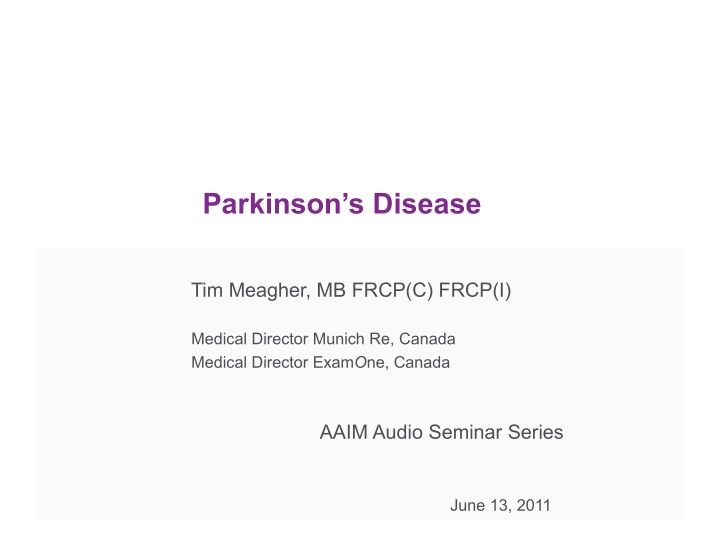



Parkinson’s Disease Tim Meagher, MB FRCP(C) FRCP(I) Medical Director Munich Re, Canada Medical Director Exam O ne, Canada AAIM Audio Seminar Series June 13, 2011
Parkinson’s Disease……200 yrs old and probably older James Parkinson (1755-1824 1500 BC ‘Kampavata ’ Galen 175 AD ‘Shaking Palsy ’ Mucuna pruriens Pierre Roche Vigneron. (Paris: Lith de Gregoire et Deneux, ca. 1865) The original description 1817 2
Clinical Description of Parkinson’s Disease Tremor Rigidity Hypokinesia Postural instability Hypomimia Decreased blink rate Nouvelle iconographie de la Salpétrière , vol 1 (1888) Micrographia Stooped posture Shuffling gait Gowers: A Manual of Diseases of the Charcot 1879 Nervous System in 1886 3
Clinical subtypes Tremor-dominant Akinetic-rigid Postural instability and gait difficulty Tremor-dominant may have fewer neuropsychological symptoms and a better prognosis Future course is difficult to predict 4
Non- motor symptoms Cognitive dysfunction and dementia Psychosis and hallucinations Depression, anxiety Sleep disturbances Fatigue Autonomic dysfunction Olfactory dysfunction Pain and sensory disturbances 5
Differential Diagnosis Essential tremor Dementia with Lewy bodies (DLB) Corticobasal degeneration Multiple system atrophy Progressive supranuclear palsy Idiopathic basal ganglia calcification Secondary parkinsonism Drugs, toxins, head trauma (boxing), structural brain lesions, Wilson’s disease Small vessel disease (Binswanger’s disease) 6
Parkinson’s Disease Dementia (PDD) 30% of PD patients have dementia (PDD) Is this a unique form of dementia, or is it Alzheimer’s Dementia? Vascular dementia? Lewy Body dementia? 7
Etiology of Parkinson’s Disease: Lewy Body Intracytoplasmic Not limited to substantia nigra Stains + for alpha- synuclein 8
Pathophysiology of Parkinson’s Disease SN: substantia nigra Striatum: (caudate and putamen) GP: globus pallidus STN: subthalamic nucleus TH: thalamus 9
Understanding the Cause of Parkinson’s Disease Progressive brain involvement Asymptomatic phase Symptomatic phase Braak, Cell Tissue Res 2004;318:121-134 10
PD Epidemiology I million people in North America Most common neurodegenerative disorder after Alzheimer’s dementia Neurodegenerative disorders will cause more deaths than cancer in 2040 Slightly more common in men Mean age at diagnosis age 70 Rare before age 40 Mortality is increased Morbidity is increased Dementia a major issue 11
Risk factors for Parkinson’s Disease Age is most important risk factor 0.3% in general population 3% > 65 yrs Number of cases is estimated to double in the next 20 years Smoking is protective 12
PD Dementia- risk factors Advancing age Number of years with PD Increasing severity of PD 13
Genetics of Parkinson’s Disease 20% of patients with sporadic PD have at lease 1 affected first-degree relative First degree relatives are 2X more likely to develop PD Twin studies suggest that genetics important in early-onset PD 2000: first PD gene mutation described- PARK1 (SNCA gene) LRRK2, Parkin and PINK1, Glucocerebrosidase (GBA) gene mutations
Investigations No gold standard test Neuroimaging generally not helpful Conventional MR usually performed to exclude other abnormalities Clinical utility of PET, SPECT not yet established 15
Treatment of Parkinson’s Disease: Education Support Exercise Speech Therapy Medication Deep Brain Stimulation 16
Treatment of Parkinson’s Disease: Medication Levodopa Dopamine agonists pramipexole MAO inhibitors selegiline COMT inhibitors entacapone Anticholinergics Amantadine 17
Treatment of Parkinson’s Disease: Novel approaches Neurotransplantation GDNF infusion Duodenal levodopa infusion Gene therapy 18
Treatment of Parkinson’s Disease: Neuroprotection 300-400,000 neurons produce dopamine Can they be protected in some way? 19
Classifying the Severity of Parkinson’s Disease: Hoehn and Yahr Scale 1. Unilateral involvement only; usually with minimal or no functional disability 2. Bilateral or midline involvement without impairment of balance 3. Bilateral disease; mild to moderate disability with impaired postural reflexes; physically independent 4. Severely disabling disease; still able to walk or stand unassisted 5. Confinement to bed or wheelchair unless aided Data from: Hoehn, MM, Yahr, MD. Parkinsonism: onset, progression and mortality. Neurology 1967; 17:427. 20
Classifying the Severity of Parkinson’s Disease: Unified Parkinson Disease Rating Scale 1. Mentation, behaviour, mood (4 elements) 2. Activities of Daily Living (17 elements) 3. Motor (15 elements) 21
PD: MR by Age Group Mortality MR (%) Observed Expected 25 - 44 0.0521 0.0063 827 45 - 49 0.0448 0.0067 668 50 - 54 0.0532 0.0230 231 55 - 59 0.0917 0.0399 230 60 - 64 0.1363 0.0690 198 65 - 69 0.2245 0.1100 204 70 - 74 0.2851 0.1768 160 75- 79 0.4263 0.2919 146 80 - 84 0.5887 0.4966 118 85+ 0.8018 1.024 80 Source : Vanacore et al. Neurology 1999;52(2):395 Mortality cancer risk in parkinsonian patients: A population-based study With permission: F Sestier, Cours de médecine d’assurance, Université de Montréal 22
Recommend
More recommend